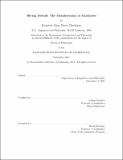| dc.contributor.advisor | Sabine Iatridou. | en_US |
| dc.contributor.author | Bjorkman, Bronwyn Alma Moore | en_US |
| dc.contributor.other | Massachusetts Institute of Technology. Dept. of Linguistics and Philosophy. | en_US |
| dc.date.accessioned | 2012-01-30T17:02:35Z | |
| dc.date.available | 2012-01-30T17:02:35Z | |
| dc.date.copyright | 2011 | en_US |
| dc.date.issued | 2011 | en_US |
| dc.identifier.uri | http://hdl.handle.net/1721.1/68911 | |
| dc.description | Thesis (Ph. D.)--Massachusetts Institute of Technology, Dept. of Linguistics and Philosophy, 2011. | en_US |
| dc.description | Cataloged from PDF version of thesis. | en_US |
| dc.description | Includes bibliographical references (p. 241-256). | en_US |
| dc.description.abstract | This dissertation is concerned with the broad question of why auxiliary verbs occur in natural language. Much previous work has assumed that the occurrence of auxiliary verbs is morphologically or syntactically arbitrary. I argue instead that auxiliary verbs, particularly BE, arise as a result of general properties morphological and syntactic systems of verbal inflection. More specifically, I propose that the existence of auxiliary BE reflects the fact that the inflectional system can fail to unite inflectional material with a main verb. I argue the reasons for this failure are structural: inflectional information combines with the main verb via Agree (Chomsky, 1998), a process constrained by relativized locality. Certain inflectional contexts isolate inflectional features from the verb because other targets for inflectional Agree intervene between them, resulting in these features being stranded. Stranded features are morphologically realized separately from the main verb; if they are affixal, this triggers the insertion of a totally default verb (BE) within the morphological component. Framing this approach to inflection in terms of Agree, however, requires modification of Chomsky's original formulation, so that inflectional feature values can be passed downward (or fail to be passed downward) from functional heads onto the main verb. I argue for a "reverse" formulation of Agree similar to that adopted in a number of recent papers (Baker 2008, Zeijlstra 2010, Wurmbrand 2011, a.o.) The resulting framework for verbal inflection predicts that different patterns of auxiliary use arise cross-linguistically due to differences in which inflectional features are able to Agree locally with the main verb. I argue that this variation can be traced two factors independently known to differ cross-linguistically: inflectional feature markedness, determining which features are visible to Agree, and the distribution of head movement, able to move the verb into local relationships with higher functional heads. Subsequent chapters extend this general approach into a variety of related domains: the alternation between HAVE and BE in auxiliary selection, the conflict between this analysis of BE and the traditional analysis of DO-support as a process that rescues stranded inflection, and the interaction of verbal inflection and auxiliaries with counterfactual inflection marking. | en_US |
| dc.description.statementofresponsibility | by Bronwyn Alma Moore Bjorkman. | en_US |
| dc.format.extent | 256 p. | en_US |
| dc.language.iso | eng | en_US |
| dc.publisher | Massachusetts Institute of Technology | en_US |
| dc.rights | M.I.T. theses are protected by
copyright. They may be viewed from this source for any purpose, but
reproduction or distribution in any format is prohibited without written
permission. See provided URL for inquiries about permission. | en_US |
| dc.rights.uri | http://dspace.mit.edu/handle/1721.1/7582 | en_US |
| dc.subject | Linguistics and Philosophy. | en_US |
| dc.title | BE-ing default : the morphosyntax of auxiliaries | en_US |
| dc.title.alternative | Morphosyntax of auxiliaries | en_US |
| dc.type | Thesis | en_US |
| dc.description.degree | Ph.D. | en_US |
| dc.contributor.department | Massachusetts Institute of Technology. Department of Linguistics and Philosophy | |
| dc.identifier.oclc | 773614323 | en_US |
